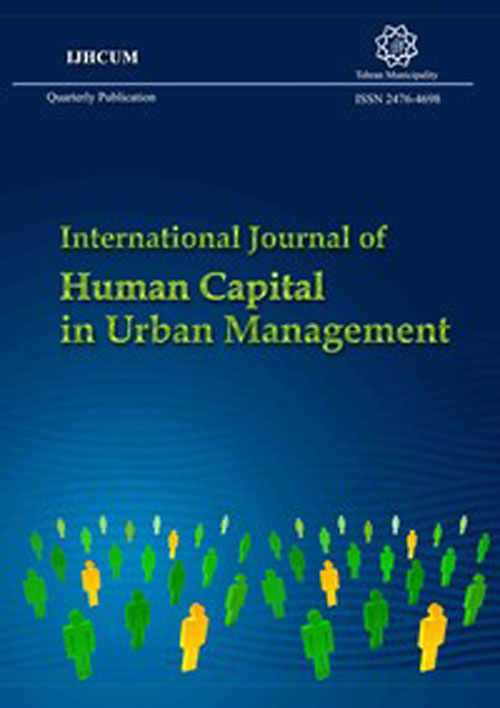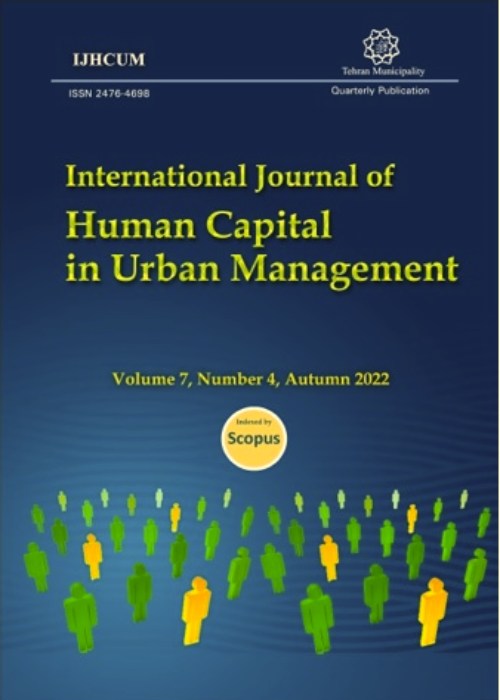فهرست مطالب

International Journal of Human Capital in Urban Management
Volume:2 Issue: 2, Spring 2017
- تاریخ انتشار: 1396/03/06
- تعداد عناوین: 8
-
Pages 89-100Heavy metals are one of the dreadful environmental pollutants. Its toxicity is a menace to the ecosystem and has attracted global concern over the decades. The attendant uncontrolled disposal and recycling of electronic-waste (e-waste) has greatly influence the elevated concentration of heavy metals observed in Nigeria waterways. This study was carried out to investigate the frequency of the deadly heavy metals as part of public health intervention. The study was a cross sectional design in which waterways from the three geographical zones of Kwara State, Nigeria were sampled by integrated composite method and analyzed for physical and chemical parameters during the dry and rainy season. High frequency of e-waste generated heavy metals in the waterways was observed with respect to influence of settlement, geographical zones and seasonal variation in the study area. The mean concentrations of the heavy metals analyzed showed a decreasing trend in their quantity as Cr Cd Pb Hg in both seasons. Statistically, no significant difference in densities of Lead, Mercury and Chromium with respect to season (P cal = 0.482 in chromium, P cal = 0.067 in Lead, P cal = 0.146 in Mercury, P > 0.05). However, there was significant difference in frequency of Cadmium by season (P cal = 0.001, P 0.05). Assessment of the findings with respect to geographical zone revealed a significant difference in the mean distribution of Chromium during both seasons. Heavy metals were also recorded to be higher in the urban areas than the rural areas.Keywords: Electronic-waste, heavy metals, Kwara State toxicity, Waterways
-
Pages 101-112The rich identity, originality and validity of "Ancient Iranian Urbanism and Architecture", always have stimulated the urban designers and planners for having research about its valuable qualities and historical principles. Unlike the past, today's Iranian cities have inefficient urban qualities; because they have inspired by the western urban designs, without paying attention to their contents and contexts, which declined the originality and identity of them. So in this research, to achieve more efficient urban design solutions, is tried to revive the concepts and principles of the ancient Iranian urbanism. Also, according to the globalization and urban commonalities, the main attempt is to find the overlaps and common qualitative norms between the western contemporary urban design approaches and ancient Iranian urbanism principles. Due to this, by utilizing the inductive, comparative and descriptive methods, is tried to have a research in theoretical resources to suggest some comprehensive principles, in order to reach an appropriate concept for the implementation of urban design projects in Iran, which may revive the original Iranian contextualism and reality. This type of research creates a linkage between the innovations of western urbanism approaches and the values of the ancient Iranian urbanism principles to have a prospective and more accurate understanding of Iranian urban developments.Keywords: Ancient Iranian Urbanism, Contextualism, Structuralism, Urban Resilience, Urban Sustainability
-
Pages 113-124Overall plant growth and microbial biomass can be effected by dust accumulation. The chloroform fumigation-extraction method was used to evaluating the effect of cement dust pollution emitted from Kurdistan cement factory on soil microbial biomass carbon. Chlorophyll content (a, b and total) of plants species was measured in different distance from cement factory. Microbial biomass C (Cmic) amounts ranged from 0.138 to 1.102 mg/g soils in the polluted sites and from 0.104 to 1.283 mg/g soils in the control area. Soils polluted with alkaline cement dust resulted in meaningful reduction in Cmic levels compared to control soils. Pearson correlation coefficients (r) show Cmic was positively correlated to soil CaCO3 content (r = 0.09). Cmic/Corg ratio was 2.54 and 1.92 in the control and cement polluted sites, respectively. Reduction in this ratio can be resulted from soil degradation in cement polluted soils. A significant decrease in the Cmic/Corg ratio in cement dust-polluted soils illustrated that this factor can be applied as a good indicator of soil quality. In the case of chlorophyll content of plant species, maximum reduction of total chlorophyll for Triticum aestivum L. was 45% compared to Hordeum vulgare L. with 60%. Therefore, results show higher sensitivity of H.vulgare than to T. aestivum.Keywords: Cement dust, Chlorophyll chloroform fumigation-extraction (CFE), Cmic-Corg ratio, Triticum aestivum
-
Pages 125-138The Kuala Selangor mangrove forest are facing massive reclamation for economic development but the conservation aspect and fisheries values of mangroves have been ignored in the decision-making process. The local community support and awareness of the mangrove forest conservation are still doubtful. The aim of the study is to analyse the local community perception on the mangrove forest conservation and management by the current and future development factor. Statistical data was generated using the SPSS software version 22 to develop a descriptive analysis and cross tabulation chi- square for data analysis and interpretation. The results reveal that knowledge and perception towards the mangrove forest are influenced by the socio-demographic factors such as age, level of education, occupation, living duration and distance from the mangrove forest. The data analysed showed that the distance of living from mangrove forest had a positive relationship towards mangrove conservation followed by age and education. Education plays a role in increasing the community awareness and appreciation of the mangrove ecology. The outcome of the study could be utilized by the policy maker and local authority by taking into account the community perception of mangrove forest development, encouraging the community participation in the decision-making process and selecting a sustainable livelihood option for the mangrove forest.Keywords: Community perception, Mangrove development, Mangrove forest
-
Pages 139-146Human capital is considered as a strategic resource among the main resources of any organization and an important factor in producing and presenting services to the society. Improving the productivity of human capital is the main cause of the improvement of productivity in organizations. Management of human capital development, focuses on the quantitative models and technics to test the productivity of the entire system. The central goal is to determine common and distinguishable indicators of human capital productivity in two levels of staff (individual) and organization (management). According to the previous researches and available managerial theories, 29 variables were selected for two main indicators in two levels of staff and organization. Due to the complexity of testing the productivity in the urban management organizations and the need to determine the variables, exploratory factor analysis test was randomly distributed and conducted among 350 people from the target society of human capital urban management (Tehran Municipality) during four phases with setting out a questionnaire consisted of 22 items in Likert scale which distributed randomly. Output of first phase supported 19 variables out of 29 first variables. In the next phase, matrix of variables (partial indicators), was formed due to the correlation coefficients and classified and defined according to two main research indicators by variance analysis in which weight of organization index and staff index were calculated 0.623 and 0.597, respectively. Therefore, programing for the improvement according to process cycle for both main indicators and other exploratory indicators was offered.Keywords: Factor analysis, Human Capital, Improvement Programming, Matrix of Variables, Productivity, Strategic Resources, Urban Management Organization
-
Pages 147-154This study aims at identifying the relationship between managers leadership style and employees job satisfaction. To achieve this aim and to examine the research hypotheses, two types of questionnaires, including Likert scale for leadership style and Job descriptive index for job satisfaction, were distributed among 218 employees in 3 different departments of Finance and Administration Deputy of Tehran Municipality. The research data analysis was carried out at inferential statistics level using SPSS software. In this study, the independent variable of leadership style was in four levels of autocratic-colonial, autocratic-charity, advisory and participatoryas well as the variable belonging to employees job satisfaction. The results showed that the third leadership style (advisory) was the dominant style in the community. There was a positively meaningful relationship between managers leadership style and employees satisfaction. There was also a negatively meaningful relationship between employment type and gender with the employees job satisfaction. Moreover, type of workplace was an influential factor in job satisfaction while its rate was not similar in each departmentKeywords: Job descriptive index (JDI), Job Satisfaction, leadership style, Likert theory, Managers
-
Pages 155-162Earlier phases of economic expansion and urban development have resulted in significant sources of urban soil contamination. Petroleum hydrocarbons are one of the most common groups of persistent organic contaminants in the environment. In this study, two types of treatment in 3 concentrations were prepared that were included plant treated by 1% oil pollution, treatment by 1% contamination without plant (as control), plant treated by 5% oil pollution, the 5% pollution treatment without plant (control), 10% oil pollution treatment with plant and 10% treatment without plant (control) that 3 replicates were prepared for each treatment. The obtained extracts were concentrated to 1 mL under a gentle stream of nitrogen gas, and then 2 μg of the sample was injected into a UNICAM 610 series gas chromatograph equipped with a flame ionization detector. Primary Total petroleum hydrocarbons amount in 1%, 5% and 10% concentration was respectively: 9027.40 mg/kg, 49599.03 mg/kg and 99548.28 mg/kg. After 4 months its amount in different concentration with plant was 126.43 mg/kg, 4463.92 mg/kg and 19611.50 mg/kg. The best total petroleum hydrocarbons removal efficiency was observed in all concentration at 120th day. The results of this study showed that vetiver can remove petroleum hydrocarbons from contaminated soils effective.Keywords: Ahvaz city, Flame ionization detector (FID), Petroleum hydrocarbons, Removal, soil, Total petroleum hydrocarbons (TPH)
-
Pages 163-170The current study presents an investigation on the waste management in the cattle slaughterhouse by the followingObjectivesa) to identify the existing waste management practices in relation to sources, quantity and characteristic of wastes; b) to identify the situation of production, collection, storage, transportation, processing and recycling, and final disposal of wastes and the problems of existing waste management practices. In order to obtain reliable information and filling the check list, site surveys were conducted when the management of the slaughter-house was interviewed in waste management practices. The total produced industrial waste in studying unit's was found to be 10252 tons/year. The per capita waste generations were reported to be 54.6 kg/cattle/day and 11.1 kg/sheep/day. Also, more than 98% of the hazardous waste produced can be infectious. However, it is important to keep in mind that setting an operational program and careful monitoring of its optimal execution by the slaughterhouse manager is necessary. Consequently, findings provide useful inputs for decision making processes around construction slaughterhouses waste management.Keywords: Slaughterhouses, Slaughterhouses waste management (SWM), Solid disposal, Waste management, Waste recycling


